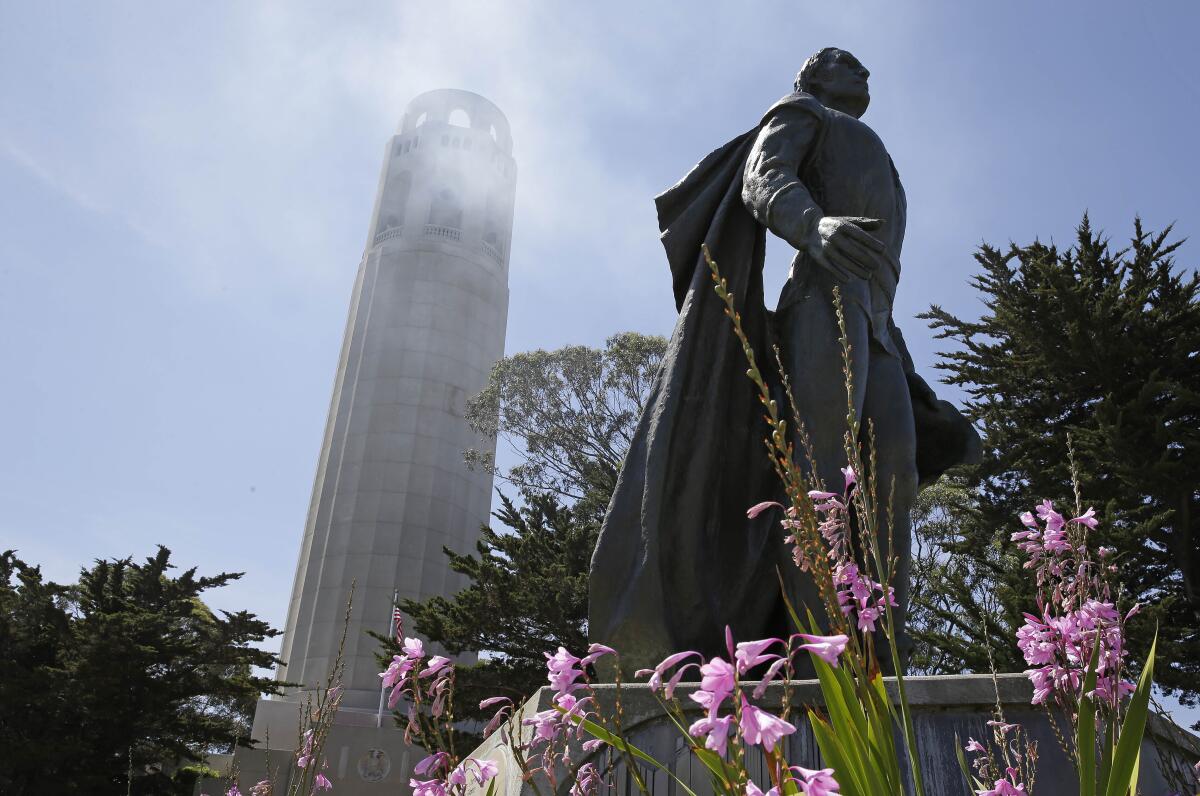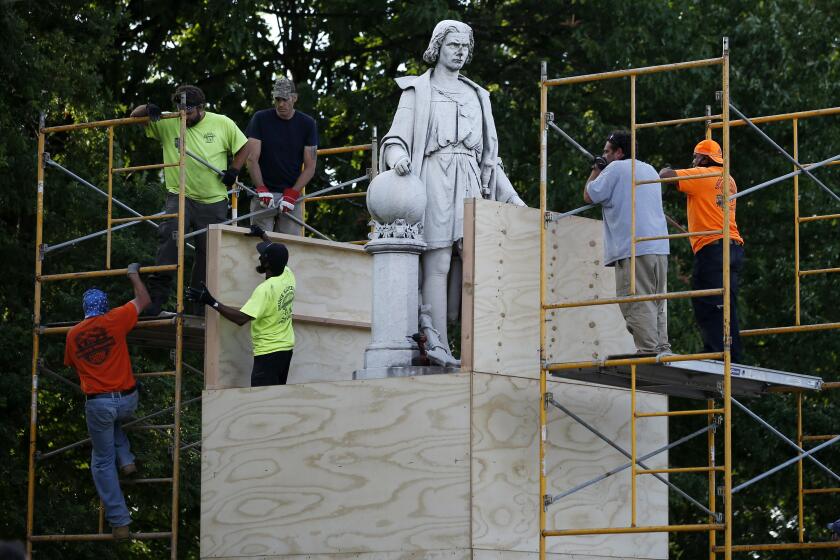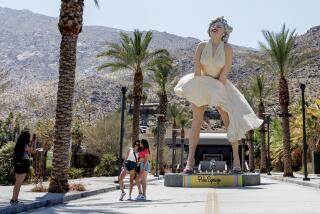Christopher Columbus statue removed from San Francisco’s Coit Tower

- Share via
A statue of Christopher Columbus near San Francisco’s Coit Tower was removed early Thursday morning and placed in storage, officials said.
The statue had generated objections in the past, but the Black Lives Matter protests amplified the displeasure with the artwork, which was defaced three times in the last week. The nationwide antiracism protests erupted in recent weeks following the death of George Floyd.
The decision to remove the statue was at the direction of San Francisco Mayor London Breed and the reasoning behind it was twofold. According to the San Francisco Arts Commission, which oversees the care of the city’s civic art collection, the installation did not align with the city’s “commitment to racial justice.” At the same time, a planned protest had circulated online calling on citizens to assemble on Friday and remove the 2-ton, 12-foot tall statue from its pedestal. Because of the risk to residents, officials said they acted proactively to remove the statue.
The bronze statue atop Telegraph Hill was installed and dedicated on Oct. 12, 1957. It was sculpted by Italian artist Count Vittorio de Colbertaldo and gifted to the city by the Columbus Monument Committee, the city of Genoa and the Marini family.
Recent vandalism of the artwork, which was previously defaced, occurred as other monuments to Columbus — as well as those commemorating the Confederacy — came under more intense scrutiny as symbols of racism in American history.
The decision, announced Tuesday by legislative leaders, has long been sought by those who say it’s wrong to honor a man who ushered in an era of genocide to North America’s indigenous peoples.
“At a time of great unrest and deep reflection by our country, we recognize the pain and oppression that Christopher Columbus represents to many. We believe that through public art we can and should honor the heritage of all of our people, including our Italian-American community, but in doing so we should choose symbols that unify us,” Supervisor Aaron Peskin said in a statement.
The announcement was made on behalf of Peskin, Breed and Supervisor Catherine Stefani.
Stefani previously presented a resolution to recognize October as Italian American Heritage Month after city supervisors voted to replace Christopher Columbus Day with Indigenous Peoples Day.
“As a proud Italian American, this was not a decision I came to lightly, but this is a time for healing,” Stefani said in a separate statement about the statue’s removal.
“I know as well as anyone that Columbus has historically been a symbol of pride in Italian Americans’ contribution to this nation. But Columbus also represents the painful foundations of American history — the slavery, subjugation and conquest we must all condemn.”
Five hundred years after Columbus first set foot in the Americas, Joseph Cervetto Jr., portraying the Genoese navigator in San Francisco’s Columbus Day celebration, will re-enact the landing on the city’s waterfront.
The removal of the Columbus statue at Coit Tower follows actions throughout the state and around the country to eliminate effigies and monuments connected to racism. On Monday, a statue of John Sutter — a colonizer of California during the Gold Rush — was removed from Sutter Medical Center in Sacramento after it was defaced amid complaints of racism.
On Tuesday, California legislative leaders announced their decision to remove a statue of Columbus and Queen Isabella from the Capitol rotunda in Sacramento after 137 years.
“Christopher Columbus is a deeply polarizing historical figure given the deadly impact his arrival in this hemisphere had on indigenous populations,” a statement from Senate President Pro Tempore Toni G. Atkins, Assembly Speaker Anthony Rendon and Assembly Rules Committee Chair Ken Cooley noted Tuesday.
“The continued presence of this statue in California’s Capitol, where it has been since 1883, is completely out of place today. It will be removed.”
Elsewhere in California, entire cities are grappling with legacy names. In Fort Bragg, a Northern California town named after Confederate Army general and slave owner Braxton Bragg, the City Council is considering changing the town’s name by adding a query on the November ballot.
Meanwhile, U.S. House Speaker Nancy Pelosi (D-San Francisco) said Thursday that she had ordered four portraits of speakers who served in the Confederacy to be removed from the U.S. Capitol. The paintings will be taken down Friday in commemoration of Juneteenth, the holiday that marks the end of of slavery.
“There is no room in the hallowed halls of this democracy to memorialize people who embody violent bigotry and grotesque racism of the Confederacy,” she said.
More to Read
Sign up for Essential California
The most important California stories and recommendations in your inbox every morning.
You may occasionally receive promotional content from the Los Angeles Times.















